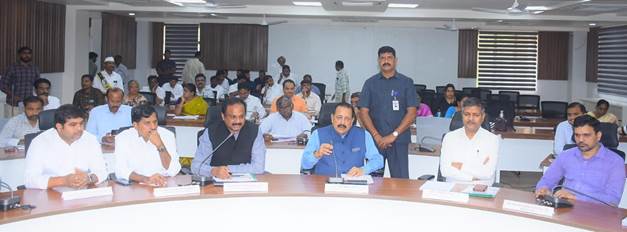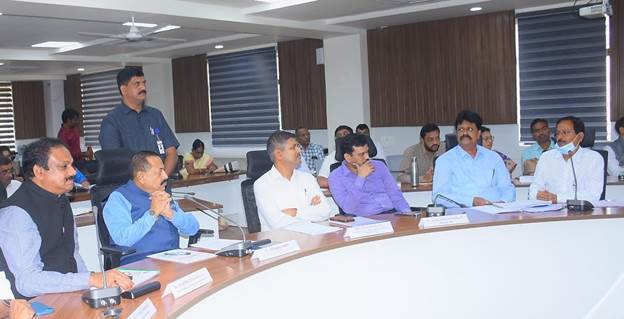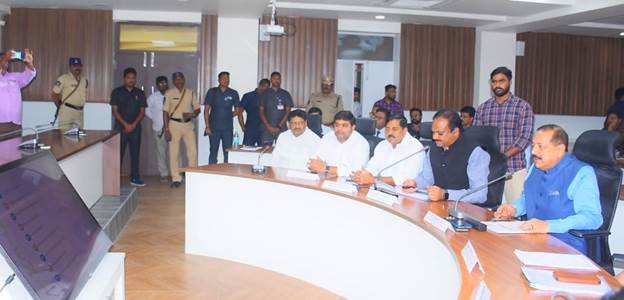Union Minister Dr. Jitendra Singh Visits YSR Kadapa and Reviews Developmental Initiatives Under Aspirational Districts Programme
- Minister Highlights Focus on PM SuryaGhar scheme, PM Kisan, and PM Vishwakarma; Calls for Active Role of Public Representatives
- YSR Kadapa under top 3 ranks since 2019: A Success Story of Aspirational Districts Programme
Union Minister of State (Independent Charge) for Science and Technology; Earth Sciences and Minister of State for PMO, Department of Atomic Energy, Department of Space, Personnel, Public Grievances and Pensions Dr. Jitendra Singh conducted a comprehensive review of developmental initiatives in YSR Kadapa district during his visit as part of the Aspirational Districts Programme (ADP).
The review showcased remarkable achievements in health, education, agriculture, infrastructure, and financial inclusion, establishing YSR Kadapa as a model district under the initiative launched by Prime Minister Narendra Modi in 2018. Dr. Jitendra Singh, appreciated the district’s exceptional progress in improving socio-economic indicators.

The Minister emphasized the importance of targeted interventions and collaborative governance, which have been pivotal in transforming YSR Kadapa into one of the top-performing districts in Andhra Pradesh. The district has achieved a 100% rate of institutional deliveries, surpassing both state and national averages, and reduced Severe Acute Malnutrition (SAM) among children under six years to an impressive 0.6%. With full immunization coverage now at 99% for children aged 9–11 months and 96% of pregnant women receiving antenatal care in their first trimester, YSR Kadapa has set benchmarks in maternal and child health outcomes. These accomplishments are attributed to effective implementation of flagship programs like POSHAN Abhiyaan and Ayushman Bharat, complemented by a robust local health infrastructure.
In education, the district has reported a 100% rate of functional drinking water, electricity, and toilet facilities in schools. It also ensures that all students receive textbooks within one month of the academic year’s commencement. Transition rates from primary to secondary levels stand at an impressive 98%, while female literacy has risen to 72.3%. The initiatives under the PM SHRI scheme, aimed at creating state-of-the-art learning environments, have further strengthened educational outcomes, fostering holistic development among students.

Agriculture in YSR Kadapa has seen a significant boost with the adoption of modern practices and technology. Micro-irrigation now covers 65.17% of the net sown area, a leap from 41.59% in 2018, while 6,950 soil health cards distributed this year have empowered farmers with essential knowledge for optimizing yields. Artificial insemination and animal vaccination programs have further enhanced productivity in allied sectors. Under the Pradhan Mantri Kisan Samman Nidhi (PM-KISAN) scheme, ₹126 crores have been disbursed to 2,10,481 farmers, underscoring the government’s commitment to supporting rural livelihoods.
The district has made remarkable progress in infrastructure development. Nearly 95% of households now have access to tap water under the Jal Jeevan Mission, ensuring safe drinking water for over 2.7 lakh families. Housing projects under the Pradhan Mantri Awas Yojana (PMAY) have provided pucca homes to over 96,000 families across rural and urban areas, with investments exceeding ₹1,159 crores. Additionally, YSR Kadapa has achieved 100% connectivity through all-weather roads, improving accessibility for remote communities and enabling better economic opportunities.
Financial inclusion efforts have empowered residents with 2.59 lakh Jan Dhan accounts opened and 94.7% linked to Aadhaar. Mudra loans worth ₹825 crores have fueled the entrepreneurial spirit of small business owners, while skill development programs under the PM Kaushal Vikas Yojana have certified over 17,500 youth, enhancing their employability and contributing to the district’s economic growth.

During his visit, Dr. Jitendra Singh acknowledged the district’s success as a testament to the effectiveness of the Aspirational Districts Programme. He highlighted how the convergence of government schemes, real-time data monitoring, and community participation has created a sustainable model for development.
Dr. Jitendra Singh has directed the district administration to organize workshops aimed at raising awareness about the benefits of various Central Government schemes. Emphasizing the need for effective outreach, the Minister highlighted the importance of educating the public, especially in rural and remote areas, about the opportunities and resources available under these schemes. The workshops will serve as a platform to bridge the gap between policy formulation and grassroots implementation, ensuring that the intended beneficiaries can avail themselves of the schemes efficiently and seamlessly.
The Minister emphasized the need to focus on flagship schemes such as PM Suryaghar, PM Kisan, and PM Vishwakarma, which aim to empower various sections of society. He stressed the importance of active involvement from public representatives to ensure greater public participation and effective implementation of these schemes. Highlighting the pivotal role of collaboration, the Minister urged all stakeholders to work together to maximize the benefits for the intended beneficiaries.
The Minister emphasized the need for district authorities to raise awareness about the Ayushman Bharat PM-JAY scheme. He highlighted that health coverage is now extended to all senior citizens aged 70 years and above.
Dr. Jitendra Singh emphasized the need to replicate the best practices from YSR Kadapa across other aspirational districts in India to ensure balanced development nationwide. He assured the district of continued support from the central government to sustain its upward trajectory. The district’s transformative journey, driven by a blend of policy innovation and grassroots implementation, serves as an inspiration for other regions, aligning with the nation’s mission of achieving holistic and inclusive growth.
